Deformation Study of Strongly Structured Clays Considering Damage Effects
Abstract
1. Introduction
2. Materials and Methods
2.1. Test Soil
2.2. Test Scheme
3. Test Results and Analysis
3.1. Analysis of the Deformation Process of Disturbed Soil with Different Vibration Durations and Frequencies
- Stage A–B: pre-structural yield:
- Stage B–C: structural yield:
- Stage C–D: post-structural yield:
3.2. Determination of Sample Disturbance Degree
3.3. Evolution of Pore Structure Damage
- Pressure range of 12.5 to 400 kPa:
- Pressure range of 400 to 800 kPa:
- High-pressure range of 800 to 3200 kPa:
3.4. The Compressive Characteristics of Structurally Strong Clay at Different Disturbance Levels
- Rapid growth stage:
- Stable growth stage:
3.5. Establishment of an Empirical Formula for the Deformation Modulus Considering Soil Damage and Disturbance Factors
3.6. Validation of the Model
4. Conclusions
- 1.
- Before the soil reached structural yield, the compression index significantly decreased while the compression modulus sharply increased. After reaching structural yield, the compression index stabilized. Concurrently, the change in damage, ΔW, exhibited a dynamic evolution pattern characterized by an initial increase, followed by a decrease, and then a subsequent increase. Under identical overburden pressure conditions, samples with higher disturbance degrees demonstrated larger compression coefficients, resulting in greater compressibility.
- 2.
- For samples with the same damage degree, those exhibiting greater disturbance degrees showed larger compression coefficients, whereas their compression moduli were relatively smaller. Furthermore, the compression coefficient increased exponentially with the rise in damage degree, while the compression modulus decreased according to a quadratic function as the damage degree increased.
- 3.
- By analyzing the variation characteristics of the compression modulus and damage degree of disturbed soil samples during one-dimensional compression tests and integrating the conversion relationship between the deformation modulus and compression modulus, this study established an empirical formula for calculating the deformation modulus that accounts for soil sample damage. This formula was validated using two additional sets of experimental data, confirming its effectiveness and providing a solid theoretical foundation and practical reference for the settlement calculations of disturbed, damaged structured clay foundations.
Author Contributions
Funding
Institutional Review Board Statement
Informed Consent Statement
Data Availability Statement
Conflicts of Interest
References
- Liu, T.F.; Wu, Y.D.; Zhou, Y.F. Experimental study on disturbance deformation of soil sampler penetration based on transparent. Hohai Univ. (Nat. Sci.) 2024, 52, 77–83. [Google Scholar]
- Wang, Z.L.; Qu, J.A.; Ding, Z.D. Experimental study on the effect of structure on the compression characteristics of peaty soil layer in Kun Ming. J. Jiangsu Univ. (Nat. Sci. Ed.) 2018, 39, 337–342+354. [Google Scholar]
- Dong, J.; Chen, C.; Dong, M.; Lu, B.; Guan, Y.; Zhao, W. Influence of disturbance degree on the propped excavation stability in sandy soil in Shenyang, China. Undergr. Space 2023, 10, 150–165. [Google Scholar] [CrossRef]
- Jiao, N.; Sun, S.; Liu, J.; Guo, Q.; Ding, J.; Wan, X. Analysis of existing railway deformation caused by double shield tunnel construction in soil–rock composite stratum. Energy Rep. 2023, 9, 159–165. [Google Scholar] [CrossRef]
- Liang, Y.J.; Tan, G.; Liu, L.L. Analysis of deformation characteristics of undisturbed loess with different moisture content under lateral unloading conditions. Sci. Technol. Eng. 2023, 23, 7494–7500. [Google Scholar]
- Zhong, H.; Guan, C.H.; Liu, L.L. Study on soil strength and deformation characteristics with different moisture content in typical areas of loess foundation pit. Nanjing Univ. Technol. (Nat. Sci. Ed.) 2024, 46, 205–215. [Google Scholar]
- Wu, J.; Yang, N.; Li, P.; Yang, C. Influence of moisture content and dry density on the compressibility of disturbed loess: A case study in Yan’an City, China. Sustainability 2023, 15, 6212. [Google Scholar] [CrossRef]
- Wang, Y.; Yang, P.; Hu, Y.D. Experimental study on strength and deformation characteristics of intact loess with different water contents. J. Xi’an Univ. Arch. Tech. (Nat. Sci.) 2022, 54, 325–330. [Google Scholar]
- Tang, B.; Zhang, Y.M.; Wang, T. Experimental study on deformation characteristics of structural clay in Zhanjiang Formation. Sci. Technol. Eng. 2016, 16, 247–252. [Google Scholar]
- Yang, A.W.; Zheng, Y.X.; Xiao, M. An experimental study of the long-term deformation characteristics of artificial structured soft clay. Hydrogeol. Eng. Geol. 2019, 46, 133–140. [Google Scholar]
- Wang, J.L.; Xu, K. Deformation and dynamic behavior of foundation soil under impact loads. Sci. Technol. Eng. 2019, 20, 2411–2416. [Google Scholar]
- Lei, H.; Yang, X.; Feng, S.; Ma, T. Softening and deformation characteristics of Tianjin soft soil under principal stress rotation induced by traffic loading. Soil Dyn. Earthq. Eng. 2023, 164, 107587. [Google Scholar] [CrossRef]
- Chen, Z.J.; Zhao, R.D.; Chen, W.B.; Wu, P.C.; Yin, J.H.; Feng, W.Q. Effects of temperature on the time-dependent compression and shear behaviour of a soft marine clayey soil. Eng. Geol. 2023, 314, 107005. [Google Scholar] [CrossRef]
- Liu, J.; Xu, H.; Tao, Y.; Lyu, Q. Effects of clay content and subfreezing temperature on the freeze–thaw deformation properties of clayey soils. Catena 2024, 239, 107916. [Google Scholar] [CrossRef]
- Miao, Y.H.; Fan, J.Q. Influence of Vibration Frequency and Time onCompression Characteristics of Soft Clay Under Disturbance. J. Univ. Jinan (Sci. Technol.) 2022, 36, 261–266. [Google Scholar]
- Chung, S.G.; Kwag, J.M.; Giao, P.H.; Baek, S.H.; Prasad, K.N. A study of soil disturbance of Pusanclays with reference to drilling, sampling and extruding. Geotechnique 2004, 54, 61–65. [Google Scholar] [CrossRef]
- Schmertmann, J.H. The undisturbed consolidation behavior of clay. Trans. Am. Soc. Civ. Eng. 1955, 120, 1201–1227. [Google Scholar] [CrossRef]
- Hong, Z.; Onitsuka, K. A method of correcting yield stress and compression index of Ariake clays for sample disturbance. Soils Found. 1998, 38, 211–222. [Google Scholar] [CrossRef]
- Hvorslev, M.J. Subsurface Exploration and Sampling of Soils for Civil Engineering Purposes; National Academies: Washington, DC, USA, 1949. [Google Scholar]
- Xu, Y.F.; Chen, J.S.; Fu, D.M. Effect of shield tunneling on mechanical properties of soils. Chin. J. Mech. Eng. 2003, 22, 1174–1179. [Google Scholar]
- GB/T 50123-2019; Ministry of Housing and Urban-Rural Development of the People’s Republic of China. Geotechnical Test method Standard. China Planning Press: Beijing, China, 2019.
- Xie, Y.; Tang, B.; Shi, Y.; Liu, S.; Hu, J.; Zhang, B. The Influence of Vibration Frequency and Vibration Duration on the Mechanical Properties of Zhanjiang Formation Structural Clay. Appl. Sci. 2024, 14, 8262. [Google Scholar] [CrossRef]
- Shi, Z.H.; Tu, Z.Z.; Qian, J.G.; Huang, M.S. Shanghai deep soil samples of clayey soil disturbance evaluation method. J. Geotech. Eng. 2024, 1–10. [Google Scholar]
- Zhang, X.W.; Kong, L.W.; Guo, A.G.; Tu, Y. Physical and mechanical indexes and correlation analysis of clay with noticeable structures in Zhanjhiang area. J. Eng. Geol. 2011, 19, 447–454. [Google Scholar]
- Yin, J. The influence of structural compression characteristics of natural soft clay soil. Rock Soil Mech. 2012, 33, 48–52. [Google Scholar]
- Wang, L.Z.; Li, L.L. Construction disturbance of structural soil and its influence on settlement. Chin. J. Geotech. Eng. 2007, 5, 697–704. [Google Scholar]
- Zhang, T.W.; Xu, H.B.; Deng, Y.F. Structural soft clay damage variable and the disturbance degree of correlation study. Rock Soil Mech. 2015, 4, 958–964. [Google Scholar]
- Zhang, B.H.; Liu, S.Y.; Xie, Y.H.; Tang, B.; Huan, W.H. Study on Mechanical Properties and Microscopic Mechanism of Structural Clay in Zhanjiang Formation Under Vibration Disturbance. J/OL. Water Resources and Hydropower Technology (Both in English and Chinese). 2024, pp. 1–14. Available online: http://kns.cnki.net/kcms/detail/10.1746.TV.20240128.1432.002.html (accessed on 14 July 2024).
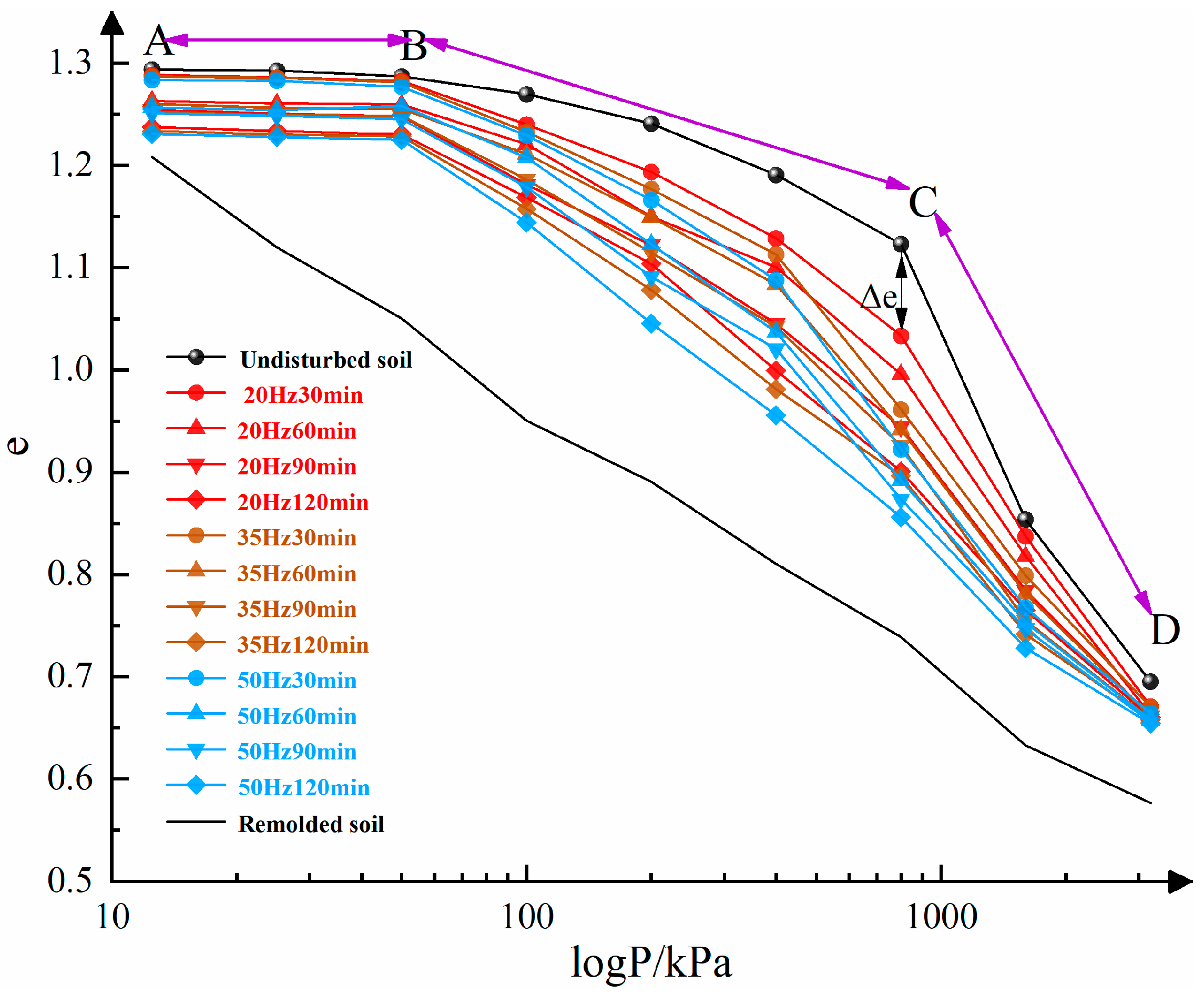
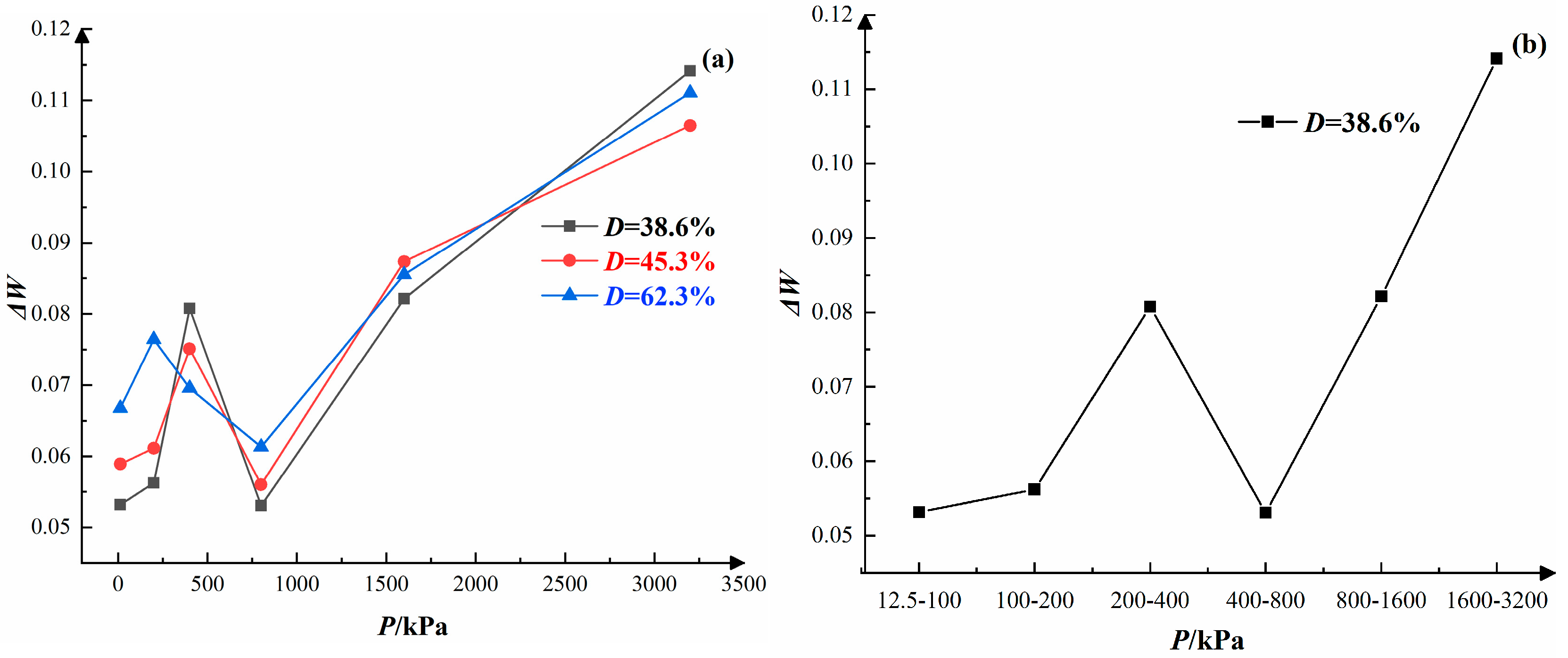
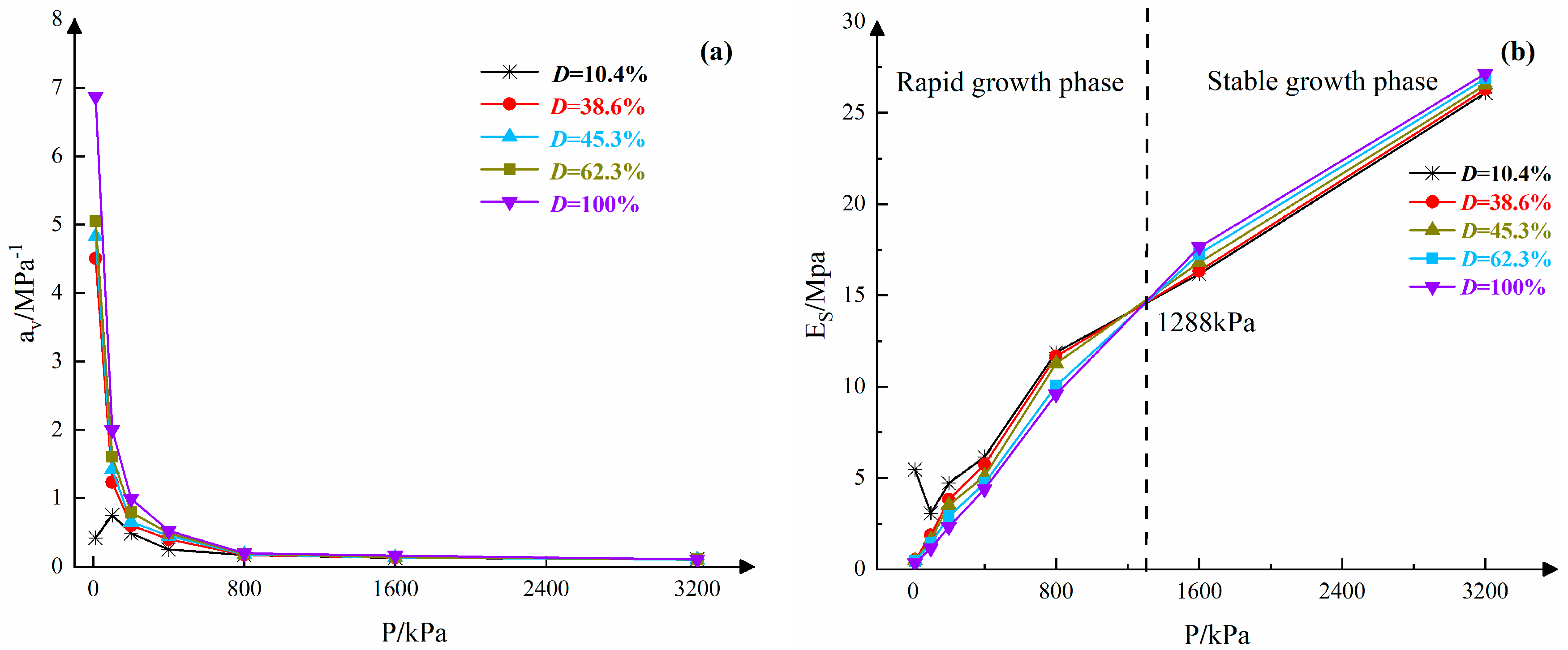
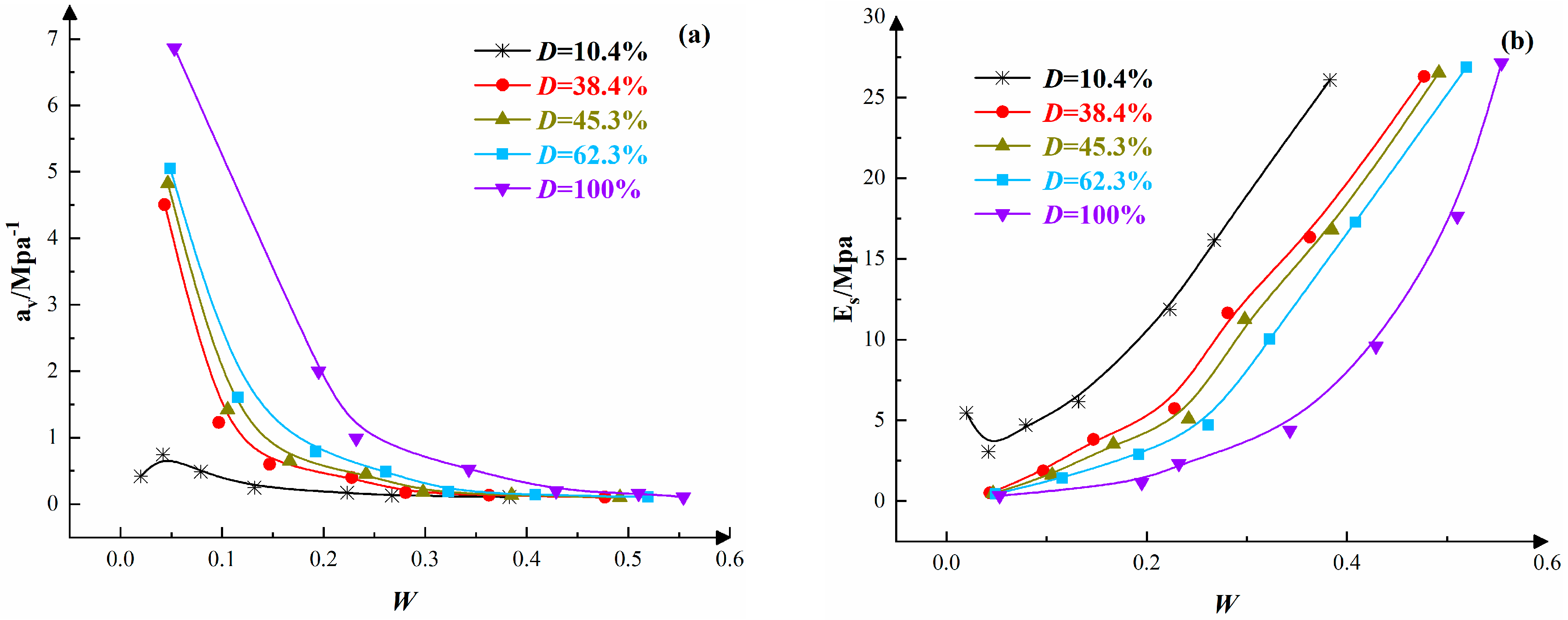
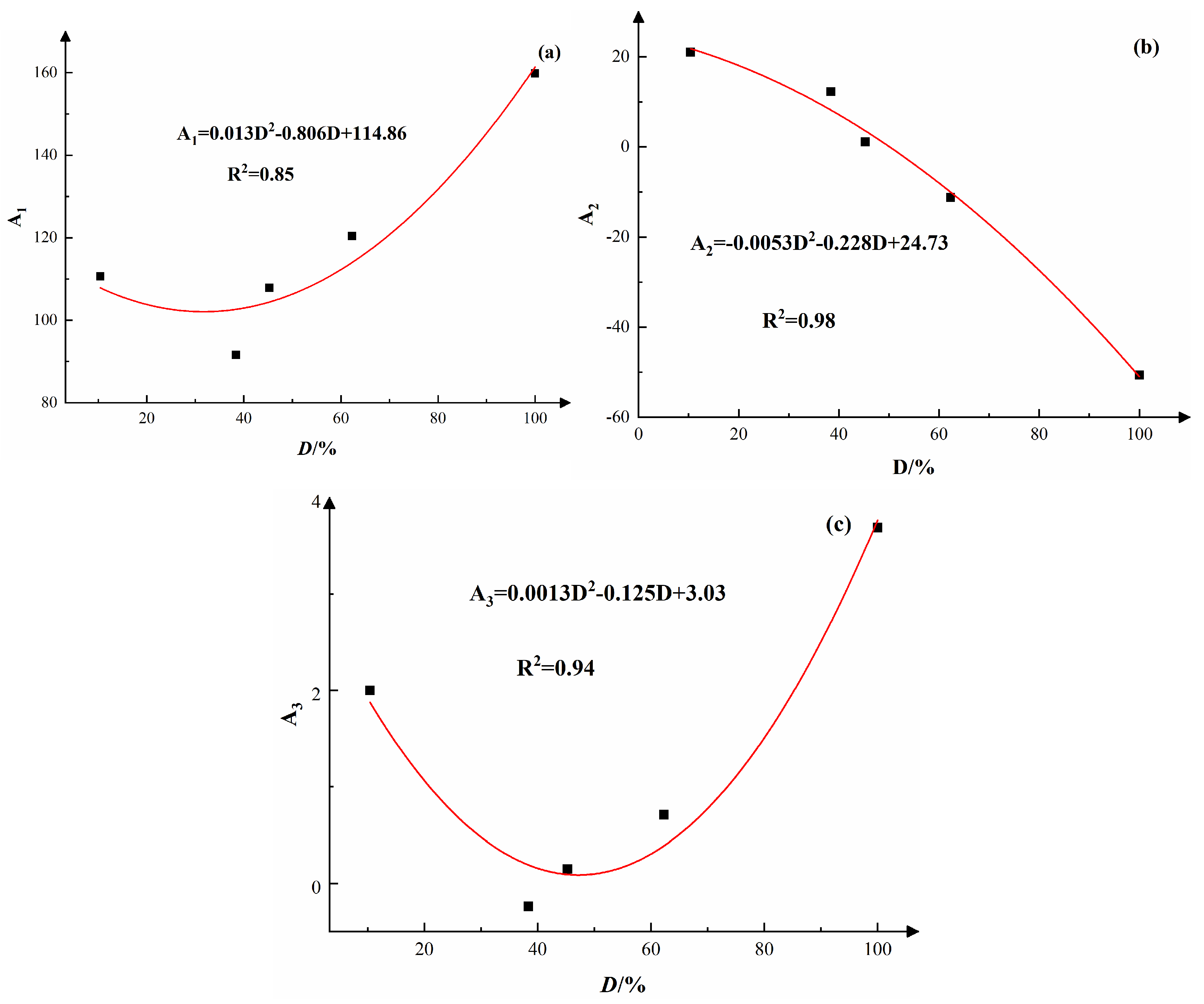

| Density ρ/(g·cm−3) | Void Ratio e | Water Content ω/% | Liquid Limit WL/% | Plastic Limit Wp/% | Sensitivity ST |
|---|---|---|---|---|---|
| 1.74 | 1.29 | 47.22 | 52.31% | 26.48% | 4.01 |
| Sample Group | Vibration Time/(min) | Vibration Frequency/(HZ) |
|---|---|---|
| A1~A3 | 30 min | 20 HZ |
| A4~A6 | 60 min | 20 HZ |
| A7~A9 | 90 min | 20 HZ |
| A10~A12 | 120 min | 20 HZ |
| A13~A15 | 30 min | 35 HZ |
| A16~A18 | 60 min | 35 HZ |
| A19~A21 | 90 min | 35 HZ |
| A22~A24 | 120 min | 35 HZ |
| A25~A27 | 30 min | 50 HZ |
| A28~A30 | 60 min | 50 HZ |
| A31~A33 | 90 min | 50 HZ |
| A34~A36 | 120 min | 50 HZ |
| Sample Group | A1~A3 | A4~A6 | A7~A9 | A10~A12 | A13~A15 | A16~A18 |
|---|---|---|---|---|---|---|
| Yield Pressure Py/kPa | 779.41 | 751.09 | 726.15 | 705.38 | 756.62 | 718.34 |
| Sample Group | A19~A21 | A22~A24 | A25~A27 | A28~A30 | A31~A33 | A34~A36 |
| Yield Pressure Py/kPa | 703.12 | 682.23 | 726.15 | 687.34 | 651.44 | 617.65 |
| Sample Group | CCLB | CCLR | D/% |
|---|---|---|---|
| Undisturbed soil | −0.0145 | −0.1400 | 10.4% |
| A1~A3 | −0.0423 | −0.1400 | 30.2% |
| A4~A6 | −0.0445 | −0.1400 | 31.8% |
| A7~A9 | −0.0466 | −0.1400 | 33.3% |
| A10~A12 | −0.0541 | −0.1400 | 38.6% |
| A13~A15 | −0.0439 | −0.1400 | 31.4% |
| A16~A18 | −0.0501 | −0.1400 | 35.80% |
| A19~A21 | −0.0562 | −0.1400 | 40.10% |
| A22~A24 | −0.0634 | −0.1400 | 45.30% |
| A25~A27 | −0.0466 | −0.1400 | 33.30% |
| A28~A30 | −0.0598 | −0.1400 | 42.70% |
| A31~A33 | −0.0714 | −0.1400 | 51.00% |
| A34~A36 | −0.0872 | −0.1400 | 62.30% |
| Remolded soil | −0.1400 | −0.1400 | 100.00% |
| Disturbance Degree D/% | Fitting Curve Equation | R2 |
|---|---|---|
| 10.4 | 0.99 | |
| 38.4 | 0.99 | |
| 45.3 | 0.99 | |
| 62.3 | 0.99 | |
| 100 | 0.99 |
| Disturbance Degree D/% | Fitting Curve Equation | R2 |
|---|---|---|
| 10.4 | 0.99 | |
| 38.4 | 0.98 | |
| 45.3 | 0.98 | |
| 62.3 | 0.99 | |
| 100 | 0.95 |
Disclaimer/Publisher’s Note: The statements, opinions and data contained in all publications are solely those of the individual author(s) and contributor(s) and not of MDPI and/or the editor(s). MDPI and/or the editor(s) disclaim responsibility for any injury to people or property resulting from any ideas, methods, instructions or products referred to in the content. |
© 2025 by the authors. Licensee MDPI, Basel, Switzerland. This article is an open access article distributed under the terms and conditions of the Creative Commons Attribution (CC BY) license (https://creativecommons.org/licenses/by/4.0/).
Share and Cite
Shi, Y.; Tang, B.; Wang, Y.; Xie, Y. Deformation Study of Strongly Structured Clays Considering Damage Effects. Appl. Sci. 2025, 15, 2969. https://doi.org/10.3390/app15062969
Shi Y, Tang B, Wang Y, Xie Y. Deformation Study of Strongly Structured Clays Considering Damage Effects. Applied Sciences. 2025; 15(6):2969. https://doi.org/10.3390/app15062969
Chicago/Turabian StyleShi, Yansong, Bin Tang, Yinchuan Wang, and Yanhua Xie. 2025. "Deformation Study of Strongly Structured Clays Considering Damage Effects" Applied Sciences 15, no. 6: 2969. https://doi.org/10.3390/app15062969
APA StyleShi, Y., Tang, B., Wang, Y., & Xie, Y. (2025). Deformation Study of Strongly Structured Clays Considering Damage Effects. Applied Sciences, 15(6), 2969. https://doi.org/10.3390/app15062969





